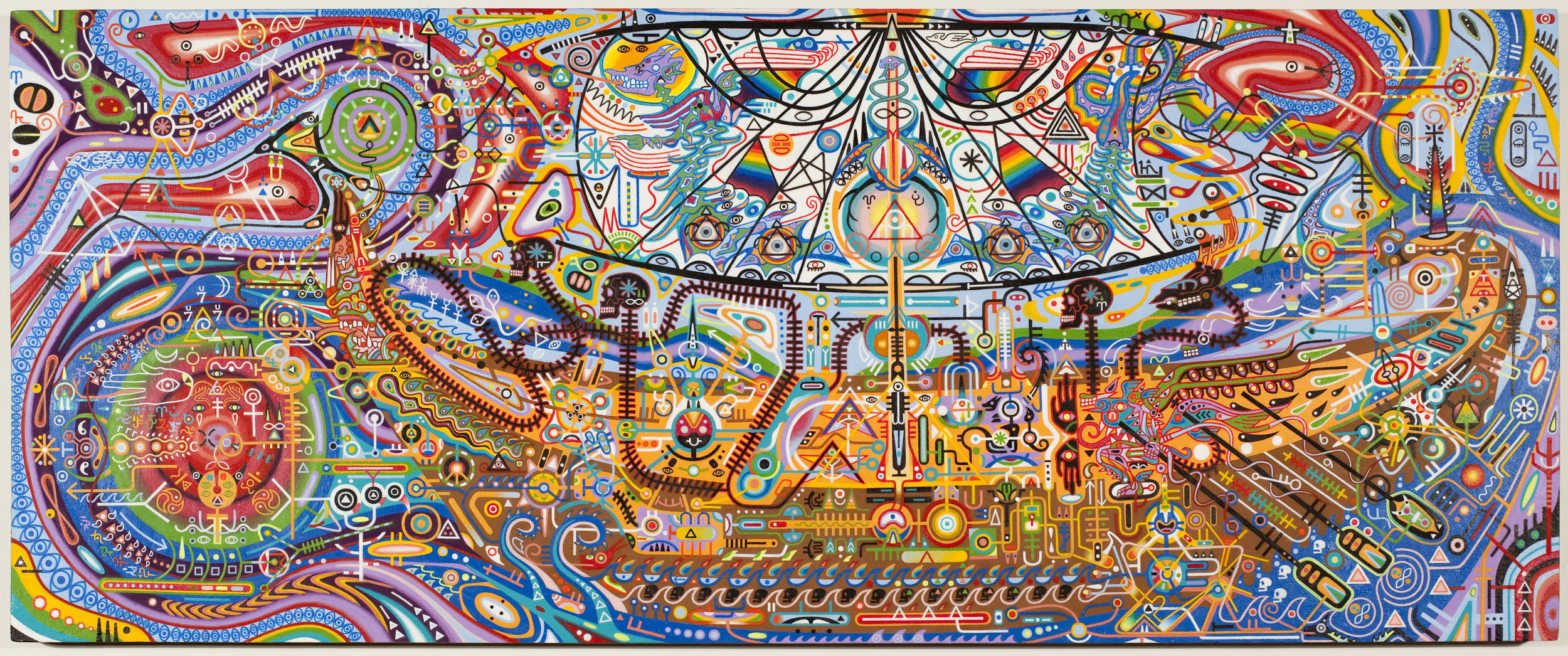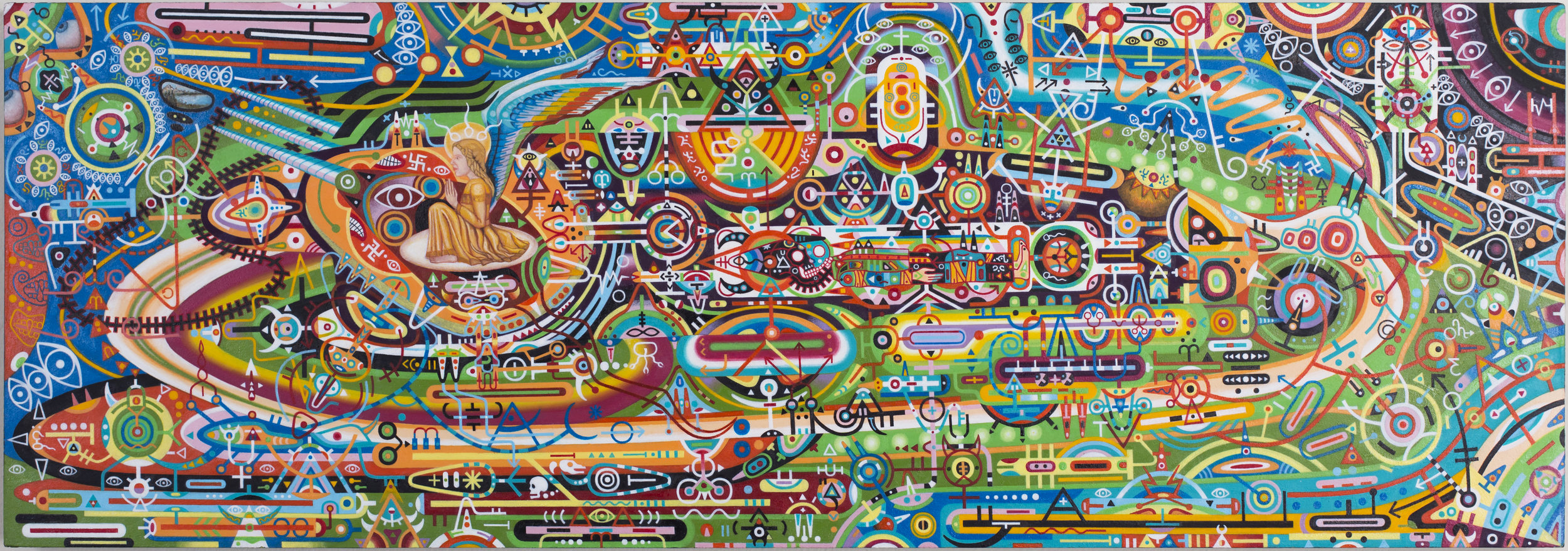This essay was produced in conjunction with the exhibition Shawn Thornton: Pareidolia, curated by Tom Burckhardt, on view at CUE Art Foundation, April 13–May 24, 2017. This text is included in the free exhibition catalogue available at CUE.
Witch Doctors at the Eye of the Solar Epoch (2008-2010) is a long, landscape-oriented oil painting on panel whose dimensions and compositional structure resemble a folded-out paper map. In urgent hues, it presents a god’s-eye view of a watery city or an entire cosmos, punctuated with networks of mystical and mathematical symbols. Curving sections of pale blue, white, and brown might be water and roadways. Yet Thornton also represents some subjects conventionally, head-on, as in his depiction of a simple, brown sailboat on blue water, which is constructed from the same blocks of color that make the map. The notations include tiny rainbows and Coptic crosses; infinity signs and directional arrows; skulls connected to spinal columns, whose geometric vertebrae look like railway tracks, rendered in brown and orange; and cartouches of ancient Egyptian hieroglyphic writing—which angels supposedly fed on parchment to spiritual seekers, Thornton said. Witch Doctors comprises multiple systems coming together and falling apart, held tentatively by invisible bonds. The modestly sized painting is worked with tens of layers of tiny, almost invisible brushstrokes. While seemingly flat at first glance, and in reproduction, the painting is actually constructed of tiny low reliefs—the slow, small brushstrokes and the shapes’ carefully-delineated borders draw the viewer’s attention to minute differences between sections.
Thornton’s colors are supersaturated and largely unmixed, taken directly from the tube. Beside his easel, he keeps a studio workbench into which is built a covered wooden tray. It contains large chunks of oil paint arranged, left to right, from cool to warm colors; each has a dried skin that he pierces to access the still wet paint inside. He works this way, he says, because his paintings take years to complete and require exactly the same vivid color palette over time. Thornton applies multiple layers of paint even on background sections, to achieve the desired color saturation and surface.
Thornton’s studio is almost as densely organized as his paintings. Finished and unfinished works on board, small square examples and wider rectangular ones, hang on the studio walls. Works in progress show that Thornton starts with large, map-like blocks of color and then gradually focuses on smaller and smaller sections of symbols. Along with his own paintings, the studio contains works by his peers that resonate with his practice aesthetically and conceptually, including an intricate paper cutout of a skull by Hunter Stabler; a semi-representational pattern print in shades of grey and black by Astrid Bowlby; and circular landscapes embroidered in tiny stitches, which resemble Van Gogh’s emotive brushstrokes, by Samantha Jorgensen, affixed to two-foot high angel figurines. Nestled amongst these works of art are toys, antiques, and esoteric objects: a transparent plastic anatomical model of skeletal, muscular, and organ structures in pink and red; an egg decorated with hagiographic motifs.
Thornton’s work recalls Jain spiritual drawings of the universe, which he shared with me. These drawings tightly condense, flatten, and systematize bird’s-eye views of earth, water, and sky, and render their stylized inhabitants as richly color-blocked, concentric circles and straight, parallel lines; they also show frontal representations of temples. Even more, Thornton’s paintings remind me of contemporary artist Jane Irish’s monumental oil and graphite depictions of traditional Vietnamese oceanic and zodiac cosmologies. Irish interrupts ancient Eastern spiritual symbology with overtly political, modern images of war, including guns, protest signs, and camouflage gear. A similarly disruptive juxtaposition of esoteric and familiar content occurs in Thornton’s work, though with different motivations. For example, he turns to mechanistic nomenclature to liken the “individual components” in his paintings to Tantric painting, in which such simple geometric arrangements as a red circle juxtaposed with a black triangle represent, say, deities receptive to human meditation. Together, he says, the tiny symbols that pattern each of his works form “a cosmos of small Tantric paintings that come together as anthropomorphic circuit boards.” This uncomfortable, alchemical bumping together of the spiritual and the scientific reveals Thornton’s driving force.
In numerous interviews, Thornton has described this body of work’s germination in traumatic medical and psychiatric experiences that persisted throughout his twenties. An undiagnosed brain tumor put pressure on his pineal gland for several years, causing blackouts, hallucinations, and terrifying sensations of unreality. The pineal gland, an endocrine structure located near the brain’s center, has been subject to metaphysical and occult speculation for hundreds of years. Madame Helena Blavatsky, whose nineteenth-century theosophical writings Thornton has read, called it the third eye of Hinduism—a mystical organ that enables spiritual seeing. The notations that populate Thornton’s paintings drew initially from his own pineal visions, which were not paranormal in nature, but pulled from his memories of cultural symbols. This exhibition’s title, “Pareidolia,” refers to one way that Thornton has grappled with the emergence of these remembered images as hallucinations. Pareidolia names the human brain’s evolutionarily expedient tendency to see patterns where none exist, for example to see faces in rock formations, wood grain, or even abstract painting.
Now, Thornton researches existent visual systems to enrich his practice. In addition to Jain and Tantric cosmologies, he is interested in medieval bestiaries, shamanic power objects, and fantastical codices by contemporary designers, including Luigi Serafini’s Codex Seraphinianus of imaginary creatures. For Thornton, these diverse iconographies are analogies for the visions he saw when ill, and for the decentered state that he still endures, rather than persuasive belief systems: “I'm sure anyone who has been sick knows this feeling of being fractured inside—you find you’re in a constant, urgent dialogue with yourself, trying to put the pieces back in order.”
Science fiction offers Thornton another byway from the straight and narrow track of empirical thought. In H. P. Lovecraft’s short story “From Beyond” (1934), an inventor who believes “strange, inaccessible worlds exist at our very elbows” stimulates his own pineal gland electronically and unveils a hitherto unknown range of human perception. As other-dimensional creatures appear, fear, chaos, and murder follow¾a reminder of our mortality, and a moral suggestion that perhaps we are better off, healthier and more content, when relying on our limited natural senses. Thornton’s Brahmastra For a New Age (UFO/Time Machine) (2010–13), is structured around a central near-ellipse—or flying saucer—marked with white, red, and green borders like planetary rings. Like Witch Doctors, this work represents its subjects in an overhead view, as in an architectural plan, and also three-dimensionally, as in an architectural elevation. This work’s title signals the danger inherent in moving beyond the known, as “Brahmastra” in ancient Sanskrit writings is a powerful weapon. In this painting, the danger is both scientific and spiritual, and made more apparent by the chaotic circuitry of connected miniature symbols that swarm the work’s surface. The combination of these digital and ancient referents, and their sheer hyperbolic quantity, produces a risk of cliché of which Thornton is aware. He told me, “I will sometimes use an image, symbol, or representation that I am aware has been overused and is a cliché, but I'll overload it through repetition, create a synergy with surrounding images, or contradict it with seemingly diametric images from a different visual vocabulary.”
While the process of painting can be meditative for Thornton, finishing a work is not cathartic, nor does making art resolve inner conflict. It is more accurate to think of these works as having a dual purpose as containers for traumatic experience and living documents of the multifaceted research into this experience. “The paintings are both talismans and malignant forces,” he told me. A trained artist, Thornton nevertheless feels close to the early-twentieth-century abstract work of German faith healer Emma Kunz and the complex maps by Swiss outsider artist and diagnosed psychotic Adolf Wölfli, as well as the work of outsider artists in his home district of West Philadelphia. As a result of his health condition, Thornton has turned to outsider methodologies, but folded them into the context of contemporary art, which his work in turn enriches. Although he is a painter, his work has much in common with the dense digital psychedelia of post-internet art, such as Kari Altmann’s Soft Mobility (2014), which organizes thousands of small, interrelated images on screen in an infinite scroll and reminds us of the overwhelming amount of digital imagery we process daily. Inspired by ancient Indian spirituality, Francesco Clemente combines pattern, notation, and multiple points of view in paintings that also have affinities with Thornton’s.
However, by framing his body of work with the exhibition title “Pareidolia,” Thornton taps a more familiar phenomenon to which almost every viewer can relate—apprehending imagery in formless clouds—to create a bridge between his fractured experience and more ordinary, cohesive perceptions of reality. His use of multiple points of view such as the blue and brown sailboat that emerges from the same sections of paint as the map-like composition in Witch Doctors at the Eye of the Solar Epoch—conjure this common kind of pareidolia. In inviting us to ask which content comes first, the boat or the map, he leads us toward an understanding of his own hallucinatory visions.
---
This essay was written as part of the Art Critic Mentoring Program, a partnership between AICA-USA (US section of International Association of Art Critics) and CUE, which pairs emerging writers with AICA-USA mentors to produce original essays on a specific exhibiting artist. Please visit aicausa.org for more information on AICA-USA, or cueartfoundation.org to learn how to participate in this program. Any quotes are from interviews with the author unless otherwise specified. No part of this essay may be reproduced without prior consent from the author. Lilly Wei is AICA’s Coordinator for the program this season.
Becky Huff Hunter is a writer and critic in Philadelphia, who has contributed to Artforum, Frieze, Art Papers, Sculpture, and the Two Coats of Paint blog. She was the founding editor of the Notes platform for new perspectives on art at the Institute of Contemporary, University of Pennsylvania, where she also curated several online exhibitions.
Mentor Nancy Princenthal is a New York-based critic and former Senior Editor of Art in America; other publications to which she has contributed include Artforum, Parkett, the Village Voice, and the New York Times. Her book Agnes Martin: Her Life and Art (Thames and Hudson) was published in June 2015. She is also the author of Hannah Wilke (Prestel, 2010), and her essays have appeared in monographs on Shirin Neshat, Doris Salcedo, Robert Mangold and Alfredo Jaar, among many others. She is a co-author of two recent books on leading women artists, including The Reckoning: Women Artists of the New Millennium (Prestel, fall 2013). Having taught at the Center for Curatorial Studies, Bard College; Princeton University; Yale University, RISD, Montclair State University and elsewhere, she is currently on the faculty of the School of Visual Arts.


